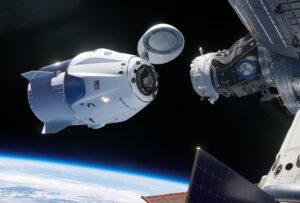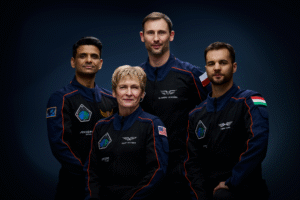Axiom Mission 4 Launches Successfully: A Global Step Towards the Future of Space Travel
Cape Canaveral, June 25, 2025 – Axiom Mission 4, a private spaceflight run by Houston-based Axiom Space in partnership with NASA and SpaceX, successfully launched early this morning and is now on its way to the International Space Station (ISS). The mission lifted off at 2:31 a.m. Eastern Time (12:01 p.m. IST) from Launch Complex 39A at NASA’s Kennedy Space Center aboard a SpaceX Falcon 9 rocket carrying a Crew Dragon capsule named Grace.

A Long-Awaited Launch
The spacecraft endured several delays before today’s successful liftoff. On June 10, the launch was postponed due to a liquid oxygen leak in the Falcon 9 booster. A second delay came on June 12 after NASA identified a pressure leak in the ISS’s Zvezda service module. The station’s Russian crew sealed the leak, and NASA declared the station safe for crew arrival.
Axiom Space CEO, supported by NASA and SpaceX, reaffirmed that safety was the top priority, even as excitement built for the mission.
International Crew on Board
Axiom Mission 4 is notable for its multicultural crew. It is the first ISS mission featuring crew members from India, Poland, and Hungary—each returning to human spaceflight after more than 40 years. They join Peggy Whitson, a veteran former NASA astronaut and mission commander.
The crew includes:
-
Commander Peggy Whitson (United States), seasoned astronaut leading the mission.
-
Pilot Shubhanshu Shukla (India), an Indian Air Force fighter pilot now serving as Axiom mission pilot.
-
Mission Specialist Sławosz Uznański‑Wiśniewski (Poland), a radiation expert and ESA astronaut.
-
Mission Specialist Tibor Kapu (Hungary), a mechanical engineer selected through Hungary’s HUNOR program.
What Happens Next
The Crew Dragon is expected to dock with the ISS on June 26 around 7 a.m. EDT (4:30 p.m. IST). The crew will remain aboard for up to 14 days.
During this time, they will conduct about 60 scientific experiments. These experiments cover fields such as human health (including diabetes research), microgravity biology, material science, earth observation, and in-orbit technology tests.
One major study will examine glucose regulation in microgravity, using continuous monitors and testing insulin pens. Though none of the crew have diabetes, their data may help improve treatments for patients on Earth and facilitate future diabetic astronauts in space.
Significance for India, Poland, Hungary
-
For India, Shubhanshu Shukla becomes the second Indian citizen in space—after Rakesh Sharma’s Soviet mission in 1984—and the first Indian to reach the ISS. His role as pilot is a milestone for India’s human spaceflight program, Gaganyaan.
-
For Poland, this marks the first Polish spaceflight since 1978. Uznański‑Wiśniewski’s mission, called Ignis, is the first ISS crew flight for Poland via ESA.
-
For Hungary, Tibor Kapu will be only the third Hungarian in space and the first since early Interkosmos missions. Selected through a national competition (HUNOR), he brings much national pride.
Commercial Spaceflight Maturing
Axiom Mission 4 is the fourth private astronaut mission to the ISS since 2022, all organized by Axiom Space in collaboration with NASA and flown by SpaceX. These missions, priced around USD 65–70 million per seat, show a shift toward commercial participation in low Earth orbit, supporting NASA’s goal of transitioning ISS operations to the private sector before retirement by 2030.
Axiom Space is working toward building its own commercial space station, Axiom Station, and missions like Ax‑4 will help test technology, operations, and partnerships that are crucial for that future.
Educational and Outreach Activities
The crew will also engage in outreach during their stay aboard the ISS. Events include educational broadcasts, amateur radio contacts with schools, and STEM activities. These are meant to inspire the next generation of scientists and engineers .
In India, several schools and planetariums live‑streamed the launch. For example, the Guwahati Planetarium held a special viewing event for students, calling it an opportunity to spark interest in space science.
Looking Ahead
Ax‑4 will return to Earth around mid-July with an ocean splashdown. The data and success from this mission are expected to guide Axiom’s next venture, Axiom Mission 5, tentatively scheduled for May 2026.
For Axiom Space, every mission contributes to a growing track record of commercial spaceflight, paving the way for continuous human presence in low Earth orbit. For participating nations, these missions are redefining their space legacies: India in particular gains key experience ahead of Gaganyaan, its first fully indigenous human spaceflight project .








